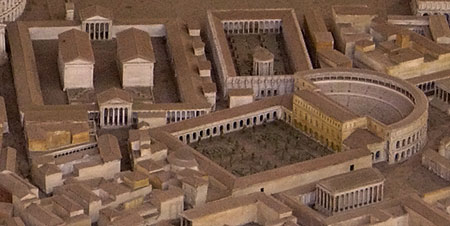
As you stroll east on the Vicus Pallacinae, you come upon the Theater of Balbus, the subject of much bragging by your friends who were present at its opening festivities. You are not prepared to be impressed, as you have just come from your favorite, the grand old Theatrum Magnum of Pompey, slightly to the north and west of here, and you are eager to see the play going on at the new Theater of Marcellus, still ahead to the south. However, the opulence of this small theater, which seats only about 8,000, encourages you to continue on into the adjoining portico area, by all accounts most astonishing to see.
This elegant structure is named after its Spanish-born soldier-builder, Lucius Cornelius Balbus Minor, the scion of Lucius Cornelius Balbus Maior and the second member of his family to distinguish himself in Rome by backing the Caesarian party. Balbus the Younger dedicated this theater, with the approval of Augustus, in 13 BCE, some time prior to the dedication in the same year of the Theater of Marcellus. Balbus' dedication celebrations were extravagant, carried out as planned despite the flooding of the Campus Martius by the Tiber River.
Although an equestrian statue of him survives, time and memory were unkind to both the builder and his monument: there is no mention of either in surviving contemporary inscriptions or Augustan texts. In fact, with no overt acts of hostility by ruling emperors, the Theater of Balbus was expunged from the physical landscape of Rome by succeeding events.
By 13 BCE three permanent stone theaters of different sizes -- and probably intended for different types of ludi -- had been constructed in the Campus Martius: the largest was built by Pompey (see Theatre of Pompey Project) and the other two, smaller in size, were built under the auspices of Augustus.